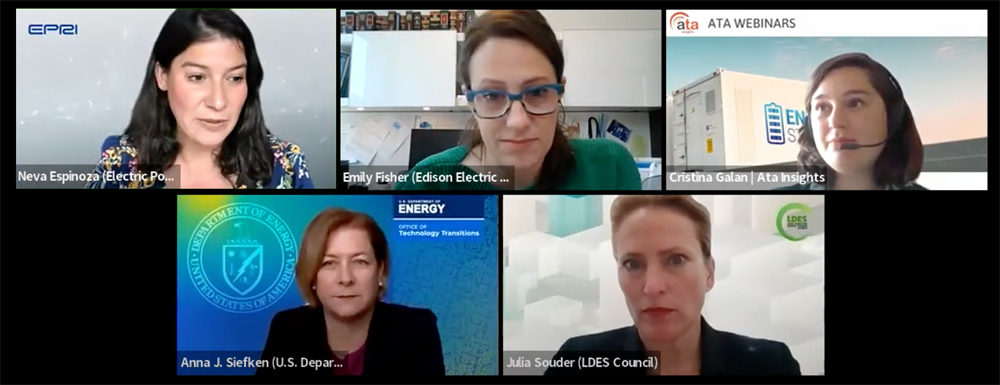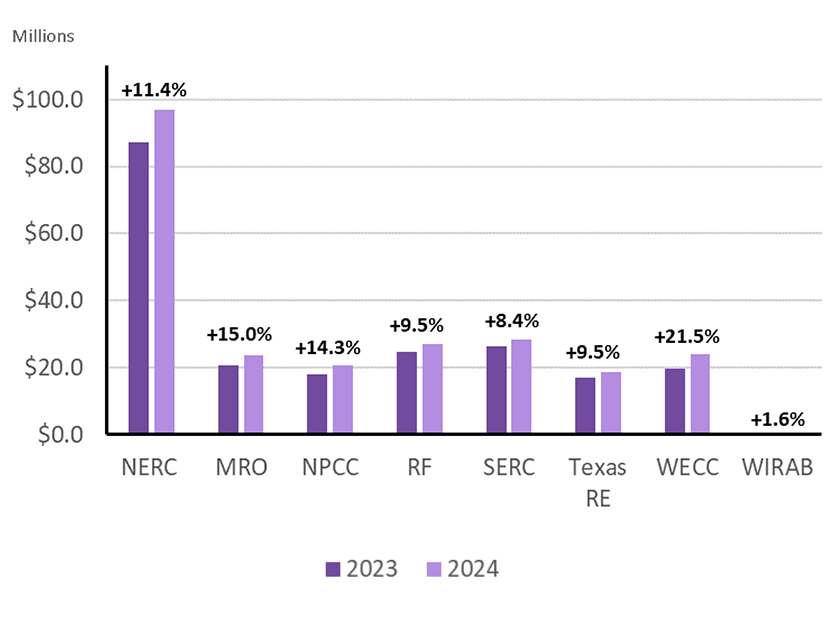Long-duration energy storage has emerged as key to enabling the continued growth of renewable energy. It also could help address the backlog of new transmission projects both in the U.S. and globally, say industry and Department of Energy experts.
But there’s no consensus about the best way to store massive amounts of energy for more than a few hours or days, whether the technology is pumped storage, mechanical weights, compressed air or massive batteries. The 2030 DOE minimum storage target is at least 10 hours for utility-scale storage. (See DOE Targets 90% Cut in Cost of Long-duration Storage.)
“Given that there are so many different technologies that are being developed, it’s the government’s hope that we can try these out geographically as much as we can,” said Anna Siefken, a senior adviser in the Office of Technology Transitions at DOE, during a webinar with energy industry experts Wednesday presented by Madrid-based ATA Insights.
“We are not picking winners here. We’re trying to raise the floor, raise it so that everyone can participate in this market. But that does [require] off-takers. It takes people who are willing to go in on the risk, and the federal government is trying its best through any number of different programs to de-risk the technologies as much as possible,” she added.
Siefken also referred viewers to DOE’s Long Duration Energy Storage Report issued in March, one of a series of reports detailing the agency’s efforts to work with industry to commercialize clean energy technologies, particularly as an industrial strategy. (See DOE Reports Highlight 3 Technologies to Decarbonize U.S. Economy.)
“We’ve done clean hydrogen, advanced nuclear, carbon management and long duration energy storage, which is again why we’re here today.
“We were looking domestically at what are the barriers and challenges to commercialization of different technologies, and we wanted to create a credible fact base as well … [and] a language so that we can talk together about what we want to do, with long duration energy storage, in particular, for that report,” she said of the Liftoff Reports.
“We are pushing forward on clean energy technologies in a way that has not happened in the United States, ever. This is a moment in time. It’s very important. What we’re doing is trying to accelerate as many technologies forward as possible,” Siefken said.
 Clockwise from top left: Neva Espinoza, EPRI; Emily Fisher, Edison Electric Institute; Cristina Galan, ATA Insights; Julia Souder, Long Duration Storage Council; and Anna Siefken, DOE Office of Technology Transitions | ATA Insights
Clockwise from top left: Neva Espinoza, EPRI; Emily Fisher, Edison Electric Institute; Cristina Galan, ATA Insights; Julia Souder, Long Duration Storage Council; and Anna Siefken, DOE Office of Technology Transitions | ATA Insights
Julia Souder, CEO of the Long Duration Energy Storage Council, headquartered in Brussels, said backed-up transmission interconnection project queues have become a global crisis and developing effective and relatively inexpensive long-duration storage technologies could help while regulators work through the backlogs both in the U.S. and around the world.
Emily Fisher, general counsel for the Edison Electric Institute, agreed with Souder.
“One of the things that long-duration energy storage could do is defer some necessary investments in the transmission and distribution system. Not permanently, but they could create some flexibility in the transmission system that doesn’t currently exist. And that might help us get through some of our current backlog [while] trying to get more things interconnected to the grid, at least in the US,” she said.
The Storage Council was formed at COP26 “to initiate this $4 trillion marketplace and bring this diversity of thermal, mechanical, electrochemical and chemical technologies to the marketplace,” Souder said. “We have diverse technologies, and our membership spans over 20 countries and over 60 members. We’ve been growing because of … the diversity of long-duration storage, as well as the huge market opportunities.” She said the Storage Council has projected the world will need as much as 8 terawatts (8,000 GW) of long-duration energy storage by 2040.
Siefken said DOE favors working internationally on storage technologies.
“There are any number of challenges that we’ve identified domestically that are similar or have already been solved internationally. And there are a number of countries that have reached out to us directly that want to work on long-duration energy storage,” she said.
Neva Espinoza, vice president of energy supply and low carbon resources at the Electric Power Research Institute, said what’s important at this point is to encourage the development of many different storage technologies because those that are emerging are markedly different, varying from mechanical to chemical, from thermo to thermo-chemical.
“Each of those very specific technology options is unique from another in terms of the materials it uses, in terms of regional resources that may be required to best utilize that technology, in terms of how it integrates [with the grid].”
When asked by moderator Cristina Galan to explain what she meant by a “demonstration project,” Espinoza replied: “I’m specifically referring to building actual projects, integrating them into systems and operating them for relatively extended periods of time to really understand the true risk … and start the learning curve. And we need to learn from every single project as we build it.”
She added that such projects could be built on the former sites of fossil fuel power plants that already have the necessary grid connections, as well as a labor force.
Fisher, of the Edison Electric Institute, cautioned that the industry cannot know when any of the nascent technologies will become available, though she said she is convinced the engineering will be done and long-term storage will be developed.
“I believe that will happen in time. I think what we need to do is be preparing [for] the ecosystem issues that can tend to slow things down that have nothing to do with design,” she said.
“But I’m more worried about the dumb things that could get in the way, like regulatory regimes that weren’t built for [this] purpose and don’t really understand how to how to address long-duration energy storage.”
